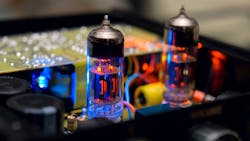So, unicorns are gone for good. But not vacuum tubes. It doesn’t seem that tubes will ever disappear completely—they’re still with us and that’s a good thing. I was reminded of that several times over the past weeks.
For example, I was scanning the ads for a high-power ham-radio amplifier. Most of the popular transceivers top out at about 100 W. For good long-distance (DX) communications around the world on the high frequency bands (3 to 30 MHz), more power is desired. A number of companies make accessory power amps to boost power level to the FCC legal limit of 1500 W.
Both transistor and tube models are available to choose from. The solid-state amps use multiple RF MOSFETs to get to levels of 500 to 1000 W. These are very expensive. To get to that same power level, you can buy an amp with one or two tubes at about half the price of the transistor model. The old but apparently still good 811 tubes are widely used. And air-cooled tubes like Eimac CX800A7 and Svetlana 4CX800A are other favorites. The tube amps are quite a bargain.
Sounding Off: Tube or Solid-State Amp?
My other reminder about tubes was in looking for a new guitar amplifier. These come in all shapes and sizes with power levels of 10 to 20 W up to over 100 W. Both tube and solid-state amps are available. Some of the smallest amps use class D switching amps that give you lots of power in a very small package.
As it turns out, there are more vacuum-tube guitar amps than solid-state amps. Most guitar players, except maybe for a few heavy metal types, prefer the sound of a tube amp. The tube sound is said to be warmer, fat-toned, and organic. It’s a personal thing as the sound difference is subtle. You have to hear the two versions to feel it or “get it.” That difference is real. The tube amps just sound better and louder with nuances.
The most popular tube amps use a pair of EL84 power tubes. These are also known as 6BQ5s. Virtually all are made in the U.K., Russia, and Europe. Like most tubes, they must be replaced every now and then. You can still get replacements for $10 to $20 each. I have also come across vacuum-tube guitar amps that still use the old 6V6 or 6L6 power tubes. I did not know these were still around, but I guess they can be had.
Guitar amps also use tubes in their preamps. Most common among them are the popular dual triodes 12AX7 and 12AU7. Some use ECC83s. There are also hybrid amps with tube preamps and solid-state power amps. You can even buy a solid-state power amp with a DSP feature that makes the amplifier sound like a tube version. Called modeling amps, these programmable units make it possible to create your own unique sound. You can also add effects like delay, tremolo, distortion, reverb, and others.
The inexpensive solid-state amps at the 10- to 20-W level sell for $100 to $200. A 100-W tube amp can sell for several thousand dollars depending on the accessories.
Vacuum tubes are still a big deal in the guitar world. And much of the appeal of tube amps to guitarists exists in those high-end audio enthusiasts. You can still buy big-buck high-fidelity amps with tubes, and many fans swear by them. It’s easy to identify a high-end audio person and some guitarists by their hearing aids or lack of hearing. Huh….
By the Book
But that’s not all….
My other reminder about the ongoing existence of vacuum tubes came in the form of a new book from Artech House titled Microwave and Millimeter-Wave Vacuum Electron Devices by A.S Gilmour. This up-to-date 900-pager covers the wide range of available microwave/mmWave vacuum tubes.
Dr. Gilmour points out in the preface that you should never use the term “tube.” These are vacuum electron devices (VEDs). The book includes all the well-known devices like traveling-wave tubes (TWTs), klystrons, magnetrons, and a few I wasn’t familiar with. This book really stands out because it uses full-color illustrations throughout to explain theory of operation and applications. It’s heavy on the theory but easy to read.
If you work with VEDs, you probably should have a copy of this for reference. And if you’re contemplating the use of VEDs, definitely get a copy of this to help you understand and select an appropriate product.
With the demise of the cathode ray tube (CRT) from TV sets and scopes, I figured that the vacuum tube era was over. It definitely is not, and maybe it never will be…completely. Don’t think of tubes as archaic losers to be avoided at all cost but rather as viable alternatives in your new electronic designs.
About the Author
Lou Frenzel
Technical Contributing Editor
Lou Frenzel is the Communications Technology Editor for Electronic Design Magazine where he writes articles, columns, blogs, technology reports, and online material on the wireless, communications and networking sectors. Lou has been with the magazine since 2005 and is also editor for Mobile Dev & Design online magazine.
Formerly, Lou was professor and department head at Austin Community College where he taught electronics for 5 years and occasionally teaches an Adjunct Professor. Lou has 25+ years experience in the electronics industry. He held VP positions at Heathkit and McGraw Hill. He holds a bachelor’s degree from the University of Houston and a master’s degree from the University of Maryland. He is author of 20 books on computer and electronic subjects.
Lou Frenzel was born in Galveston, Texas and currently lives with his wife Joan in Austin, Texas. He is a long-time amateur radio operator (W5LEF).
